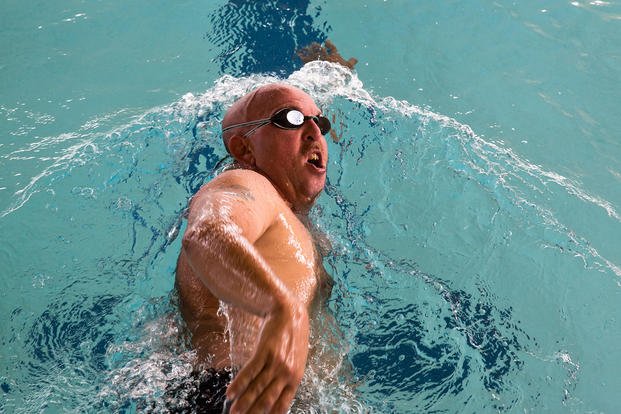When taking military swimming tests, depending upon the branch of service/special-ops unit, you will be tasked with swimming with or without fins while also demonstrating water competency.
These skills require some significant practice with lessons to learn the technique.
Here is a question from a non-swimming athlete preparing for the combat swimmer stroke test (Navy Special Warfare) and seems to be losing momentum during the swim.
Stew, I am working on my 500-yard CSS and find that I practically stop dead in the water once I kick off the wall and start my stroke. I think I am messing it up somehow. Any suggestions on the process of kicking? Thanks.
Working on off-the-wall transitions from the kickoff into the CSS stroke, it is all about being streamlined, like a torpedo. It also is about being patient and letting your body glide for 3-4 seconds before starting your stroke.
Here's how you do it:
1. Kick off the wall like you are jumping as high as you can, but horizontally and super streamlined with arms over your head, biceps on your ears and chin tucked in with one hand over the other. Keep your feet tight behind you as well.
2. Double arm pull when about 3-4 seconds into this glide. (Search breaststroke pullout.) I like to add a dolphin kick right before I do the double arm pull. Most people get this pull wrong. Think of it as grabbing as much water as you can, pulling it and pushing it behind you -- almost similar to the muscle-up movement. You should think of your arms like oars. Get them vertical in the water quickly and pull hard.
3. The kick and arm recovery. The goal here is to get back into the glide position after a breaststroke or scissor kick to maintain your momentum. If you have a good kick, you'll find you'll get another few yards of a glide out of this position.
4. Pull the top arm, turn your head and start your CSS stroke, coming up to breathe for the first time during your first actual CSS stroke of that length of the pool. Strive to get 5-6 strokes per length per 25 yards for ideal efficiency.
Why is this important?
You never will be faster in a 500-yard swim than you are the first 8-10 yards off the wall. Make the walls work for you. Don't lose this momentum during the length by broaching, popping your head up to breathe or dragging your arms outside the slipstream. Keep arms tight to your body any time you recover them overhead.
Other tips: Don't broach. Stay underwater the whole time during the kickoff until it is time to breathe.
But don't go too deep off the wall, either. Keep it at about 6-8 inches underwater during your glide.
Check out these videos:
CSS Video from Official Navy SEAL Recruiting Website
Near Perfect Form of CSS – Slow Motion
Stew Smith is a former Navy SEAL and fitness author certified as a Strength and Conditioning Specialist (CSCS) with the National Strength and Conditioning Association. Visit his Fitness eBook store if you’re looking to start a workout program to create a healthy lifestyle. Send your fitness questions to stew@stewsmith.com.
Want to Learn More About Military Life?
Whether you're thinking of joining the military, looking for fitness and basic training tips, or keeping up with military life and benefits, Military.com has you covered. Subscribe to Military.com to have military news, updates and resources delivered directly to your inbox.
















